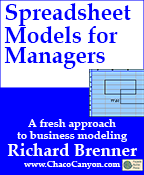Tedium, Boredom, Skip to the Details:
How To OrderWasted Time, Wasted Work, Errors, Recalls, Data
Re-entry, Data Re-Re-Entry. The lives of spreadsheet modelers and the lives of
the modelers' customers aren't pretty. The tragedy is that most of the pain, waste, and missed
deadlines are so unnecessary.
Spreadsheets are wonderful tools. They help us track what is, they help us figure out what was, and they help us predict what will be. Despite the popularity of spreadsheets, despite their wide use, and despite our familiarity with them, most of us receive only a fraction of the benefit we could derive from our work with spreadsheets.
 This Hyperbook — a stand-alone Web site you read with
your Web browser — is packed with tips, techniques, and dozens of worked examples that show
you:
This Hyperbook — a stand-alone Web site you read with
your Web browser — is packed with tips, techniques, and dozens of worked examples that show
you:
- How to manage spreadsheet development projects
- How to build high-reliability and low-maintenance models of businesses and business processes using spreadsheets
- How to exploit sophisticated mathematical techniques to reduce modeling errors and maintenance problems.
The overall philosophy is that you shouldn't need a Ph.D. to create a high-value business model that lets you predict the performance of a business process. A simple spreadsheet model is probably good enough for most business purposes, given the rapid pace of change in today's markets. But when you do make a model, it should be easy to understand and maintain, and it should be right.
This hyperbook is based on a course called Spreadsheet Models for Managers, which I began developing at the Harvard Extension School in 1993, and which I taught there until 2014. At Harvard, and wherever I've taught the course, I've had the benefit of questions, praise, complaints, wishes and criticism from hundreds of students.
This is a course about using spreadsheets to model businesses and business processes, from the perspective of a manager. It emphasizes both the modeling techniques, and the process of modeling itself. That is, we're not only interested in building models that managers need, but we want to build them in ways that are easily managed, and that give reliable and cost-effective results.
In the form of a stand-alone Web site, it includes dozens of worked examples and homework problems, with solutions. Not just descriptions of solutions (though we include that, too) — actual Excel workbooks. Moreover, the solutions are far more than just answers. They come complete with narrative explanations that discuss alternatives and tradeoffs of different approaches. And when more than one approach is possible and instructive, the solution includes both.
Here's a sampling of topics:
- Accumulations and derivations: running sums, running differences
- Relative and absolute references: what the heck are they good for?
- Operations on references: unions, intersections, and compound ranges
- Named parameters, parameter blocks: save time and reduce maintenance costs
- Drilling down and rolling up: tools for doing either one effectively
- Array formulas: manipulate whole ranges, not single cells
- Matrix multiplication: do in one row what others do in twenty
- Safety margins and crowding: save money by managing your resources
- Circular reference headaches: how to resolve them
- Convolution: simplify calculations involving time variation
- Use convolution for multiple lease events
- Terminology, styles, tips for effective charts
- Using charts to catch errors in models
- Key practices for organizations that use spreadsheet technology on an enterprise scale
- Formal technical reviews of spreadsheets: reduce errors and educate your team
- Writing macros using Visual Basic for Applications
- Inventory modeling: Economic Order Quantity (EOQ)
- Purchasing decisions in the context of volume discounting
- Modeling waiting lines
- The Fast Food Drive-Thru: How long should the driveway be?
Two formats
This course is available in two formats. All of them include worked examples and demonstrations, and all have a search capability to help you find exactly what you're looking for.
- On line
- It's available at this Web site, for those who have good access to the Internet and want to have the benefit of the continuous improvements I'm constantly making to the course.
- Downloadable hyperbook
- Or order it as a downloadable zip archive. It's only about 16.6 MBytes compressed (expands to 57 MBytes).
Details
Order on line using your credit card, or send a check payable to Chaco Canyon Consulting to the address below. Call for volume or site license pricing at the phone number below. There are three ways to go:
On line edition, one-month subscription for USD 69.95:
On line edition, three-month subscription for USD 199.00:
Downloadable hyperbook edition for USD 199.00:
Follow Rick
Send an email message to a friend
rbrendPtoGuFOkTSMQOzxner@ChacEgGqaylUnkmwIkkwoCanyon.comSend a message to Rick
![]() A Tip A Day feed
A Tip A Day feed
![]() Point Lookout weekly feed
Point Lookout weekly feed
 My blog, Technical Debt for Policymakers, offers
resources, insights, and conversations of interest to policymakers who are concerned with managing
technical debt within their organizations. Get the millstone of technical debt off the neck of your
organization!
My blog, Technical Debt for Policymakers, offers
resources, insights, and conversations of interest to policymakers who are concerned with managing
technical debt within their organizations. Get the millstone of technical debt off the neck of your
organization!related resources
- Spreadsheet clinic: custom-focused on your current projects and problems.
- Spreadsheet coaching: learn only what you need to use right now.
- Spreadsheet techniques: learn advanced modeling techniques.
- Gathering Spreadsheet Data: learn how to manage enterprise data.
- Inspections: learn how to enhance reliability and reduce effort.
- A checklist: reduce maintenance costs and the incidence of errors.
